Back to Animations: templates¶
More on animations¶
Useful tables¶
PaiTag entries & AnimationTarget values¶
AnimationTarget values and subsequent animation behavior change depending on the defined PaiTag. A comprehensive list of animation Tags and Targets can be viewed on the following page:
PaiTags and AnimationTargets ¶
bflyts, bflans, szs¶
Some .bflyts, .bflans and their corresponding .szs are also documented there:
szs, bflyt, bflan files ¶
Active and Inactive states¶
We can find specific pairs of .bflan files for some .bflyts such as <bflyt>_Active.bflan / <bflyt>_Inactive.bflan.
In the main tutorial section, we worked on RdtBtnIconGame_Active.bflan / RdtBtnIconGame_Inactive.bflan, but there are a couple others as well, e.g. RdtBtnSet_Active.bflan / RdtBtnSet_Inactive.bflan.
szs, bflyt, bflan files ¶
-
<bflyt>_Active.bflananimates<bflyt>panes when the UI element is selected -
<bflyt>_Inactive.bflananimates<bflyt>panes when the UI element is being unselected
Info
More .bflan files follow a similar logic, e.g. <bflyt>_FocusKey.bflan / <bflyt>_UnFocusKey.bflan. These aren't fully tested nor documented yet.
Warning
Edits made for Inactive .bflans will overwrite the values you might have defined in your .json layout. For example, if you've set the album button's x-coordinate to 660px in your .json while it is set to 680px in the Inactive .bflan, the 680px value will take priority over the 660px one and be applied.
Looping animations¶
It is possible to make looping animations. These can be seen
in Migush'
s JAG layout where selected game icons follow a scale up and down
idle animation. All you have to do to make a looping animation is to set the Flags value to 1 (while 0 disables
the loop) in the Pai1 section of a .bflan file. Unfortunately, more complex animations that combine multiple
transformations can't be achieved properly since the flag is applied to the whole .bflan. More explicitly, a
game icon wouldn't be able to move 10px above AND THEN follow a looping scale up and down. In such a case, the y-displacement would also be looped.
Fade in and fade out animations¶
Let's say I want a blinking cursor for the navigation menu in the settings applet. This involves using FLVC and AnimationTarget = 16. I will briefly describe the process but it is basically the same as in the main tutorial:
- Open
Set.szsthenBtnNav_Root_Active.bflan. As always when creating custom animations, do the proper modifications to thePat1andPai1sections. Add theN_BtnFocusKeyentry (cursor pane) to the list, create aFLVCentry ( notFLPA!) right under it, and then another entry underFLVC. I chose to set my key frames as shown on the screenshots below. - We'll also edit
BtnNav_Root_Inactive.bflan, otherwise navigating the tabs will interrupt the cursor animation and lock it to a certain frame (same behavior as in our previous game icon animation). Considering that, we simply " reset"N_BtnFocusKey's state (after adding this pane to the list) by setting its alpha channel to0at frame0. - For each
.bflanfile, create properly named groups in theRootGroupsection ofBtnNav_Root.bflyt. Don't forget to save all your edits. - Layout diff, compile and install, and there you go — you now have a working blinking cursor.
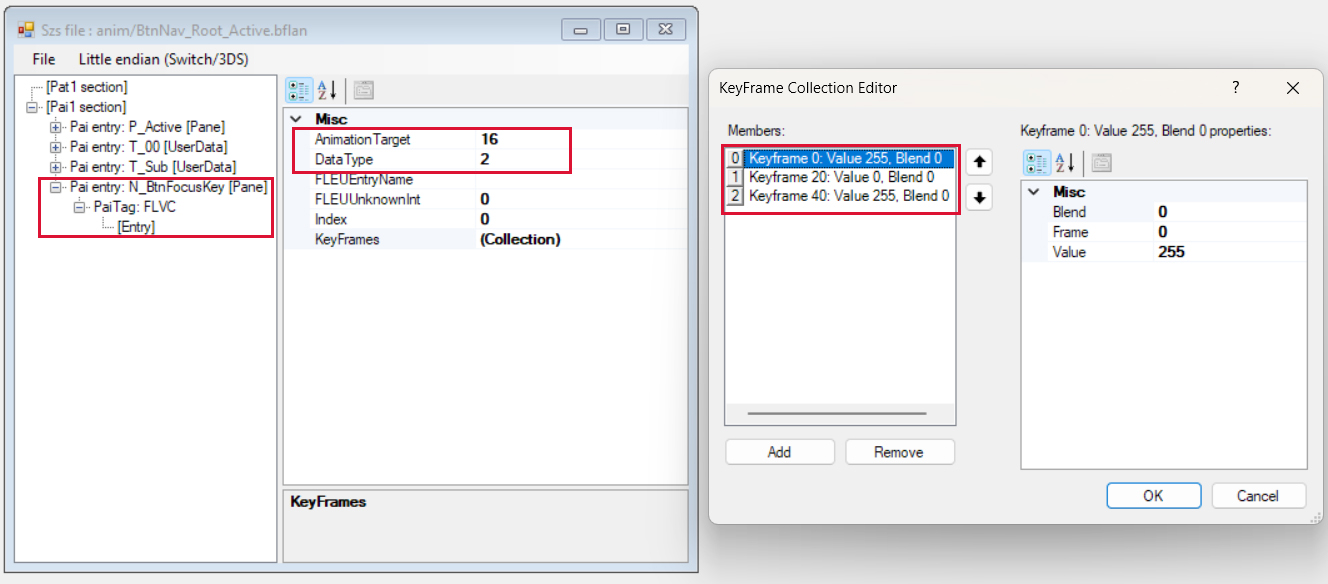 |
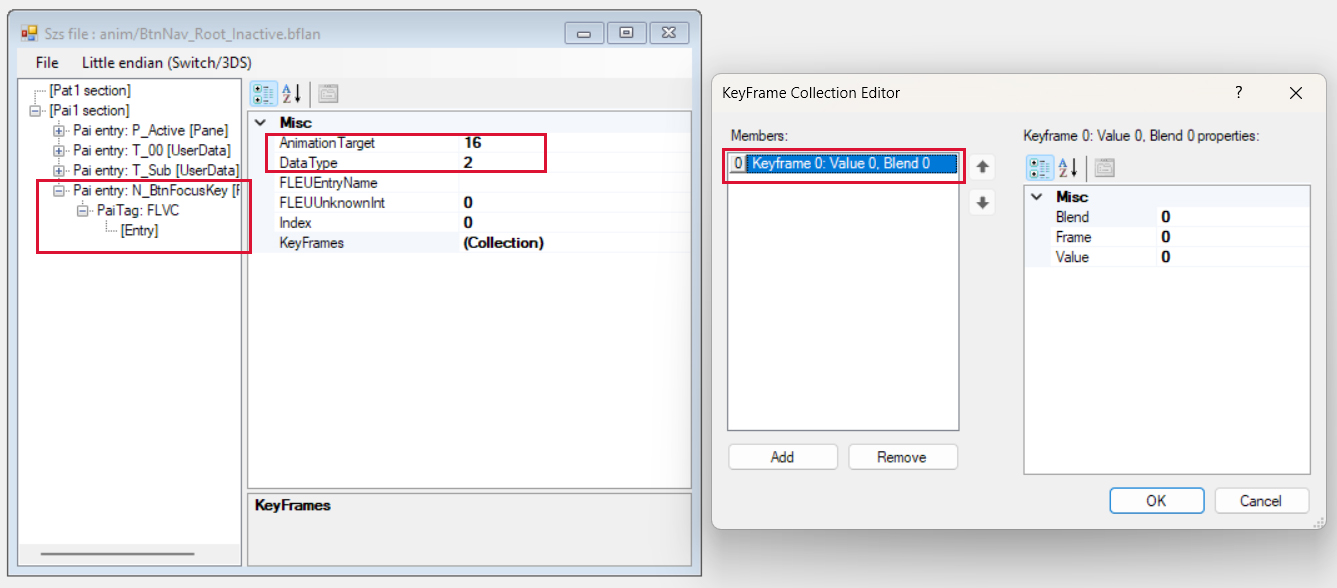 |
|---|---|
Adding FLVC entry (Active) |
Adding FLVC entry (Inactive) |
Animated backgrounds¶
Animated backgrounds have been in the trends lately (as of the time of writing). The truth is, there is some intricacy behind animated background themes, so let's make it clear once and for all.
There is no proper nor easy known way to make animated backgrounds. Switch Theme Injector only supports .dds
and .jpg files.
An alternative solution would be to animate the pane that contains your custom background image. That indeed works,
and there are a few themes that already have achieved this out there. To do so, working with ResidentMenu.szs, you
need to add L_BgNml to the pane list in RdtBase_Enter.bflan and make your edits to your convenience. However, this
solution has its limitations:
-
RdtBase_Enter.bflancontains the home screen unlocking animation. Try to loop your animation using theFlagsitem and maybe you can guess what will happen (boot loop, UI and sound glitches). The only thing you can do to sort of reproduce a looping behavior is to duplicate your animation pattern all the way through an absurd amount of key frames. Zhi actually did this in his Patterns theme with a frame limit of 64000 (which makes it about 8 minutes). If you are interested in learning the whole process, you can read through his own documentation there. As a side note, you might want to stay tuned for Zhi's next releases because he comes up with quite some good ideas! -
You're still stuck with a static background image since there is no support for animated images of any kind, nor for video files
- You could make a collage of frames in a single background (each corner a 360p image). This way you could use an animation to focus on different corners and make it look like your background has four frames. You could make it two frames by putting the images simply next to each other. You will probably have to reduce quality of each picture to ~480p. You will still have to rely on manually adding many frame entries.
- You can make gradient animations by animating Top/Bottom Left/Right corner colors, and not use a background image. Still, manually repeating the frames is required.
- On firmware versions 5.x and below you could very easily loop background animations, as the
loopflag did not affect the 'enter' animation when coming from the lockscreen.
For the other applets (e.g. settings, user page, etc.), there is actually no known way at all to apply any kind of animation to a custom background image.
Animations may overwrite things¶
If you spent some time editing .json layouts, you may have encountered cases where, no matter what you do, the
changes you make to a pane (e.g. colors, position, etc.), even while having the C_W and C_B patches enabled, lead to
no result. In such cases, chances are that an animation is overwriting your edits.
One notable case is the Redownload Software button at the bottom of the full launcher applet's main
page (Flauncher.szs). The panes corresponding to this button are L_Shop and T_Empty, and these won't hide by
simply attaching the Visible: false property to them. This is due to the FLVI entries in FlcCntMain_Type.bflan
that overwrite any modification attempt made within your .json code. To sort this out, the KeyFrames values under each FLVI entry
must be set to 0 (1 by default).
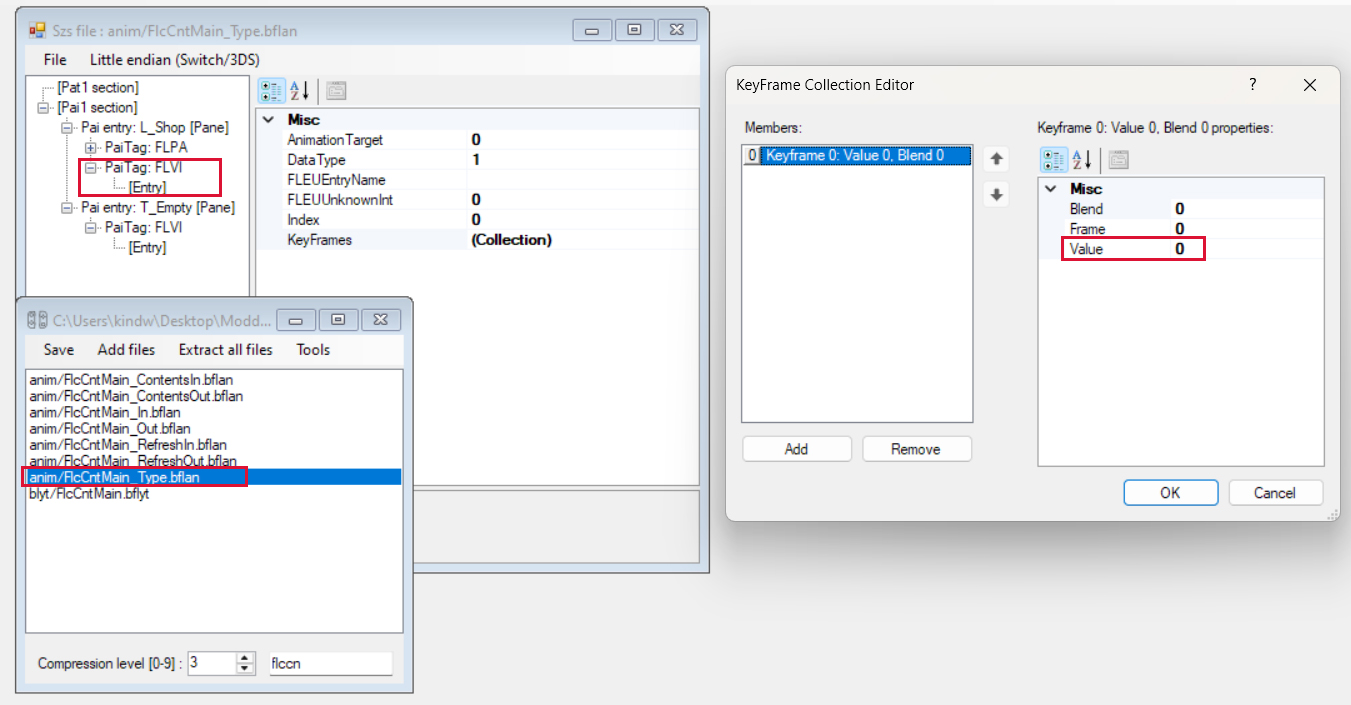 |
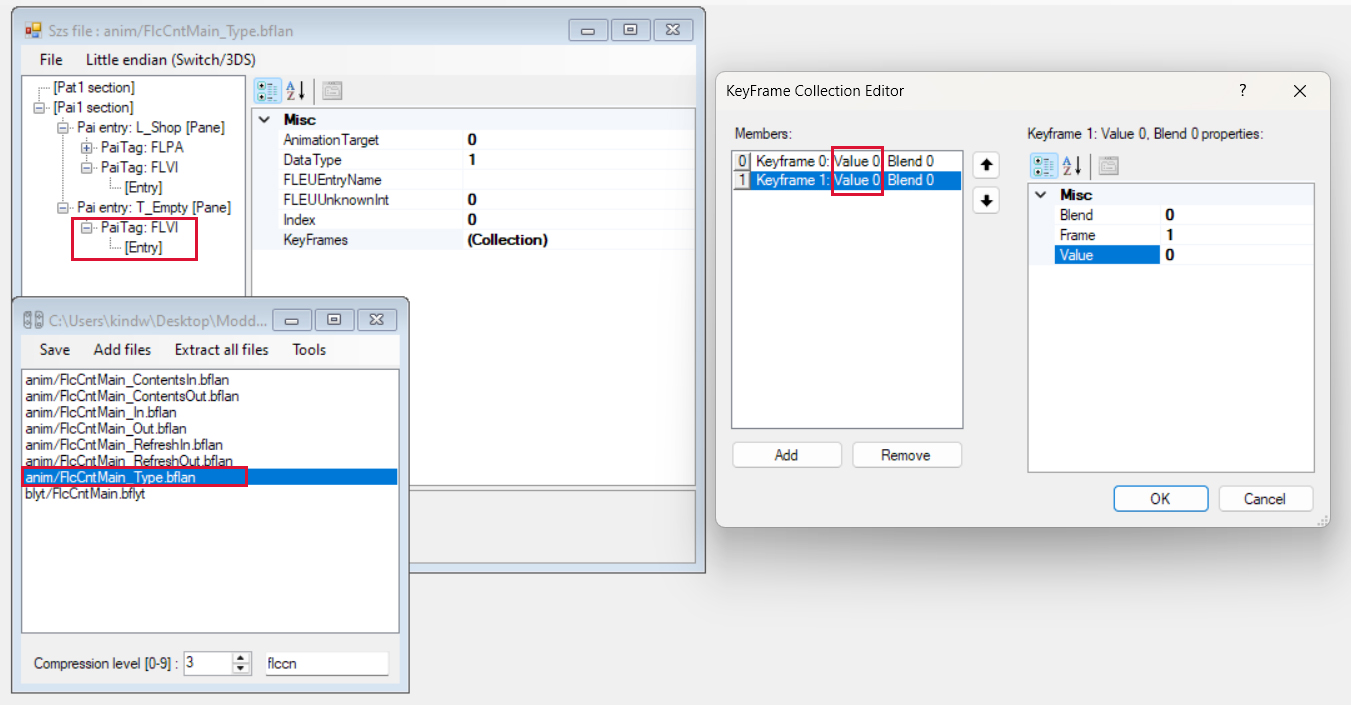 |
|---|---|
L_Shop > FLVI > KeyFrames |
T_Empty > FLVI > KeyFrames |
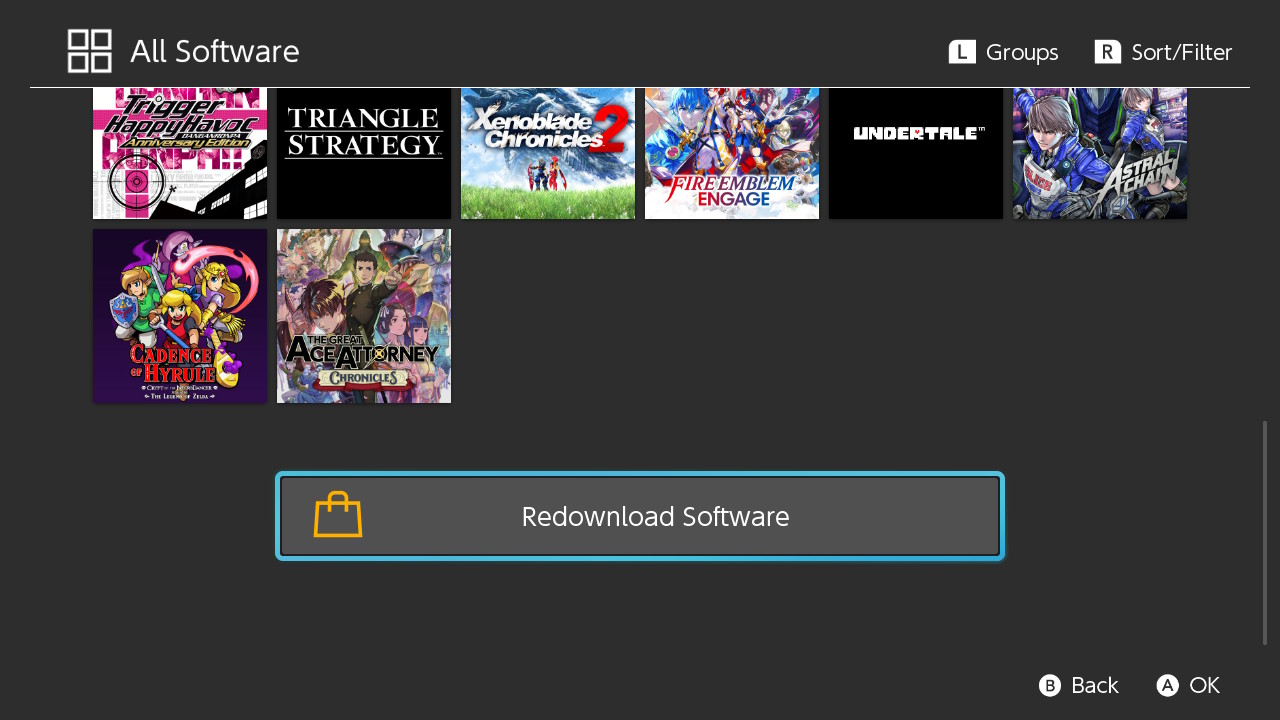 |
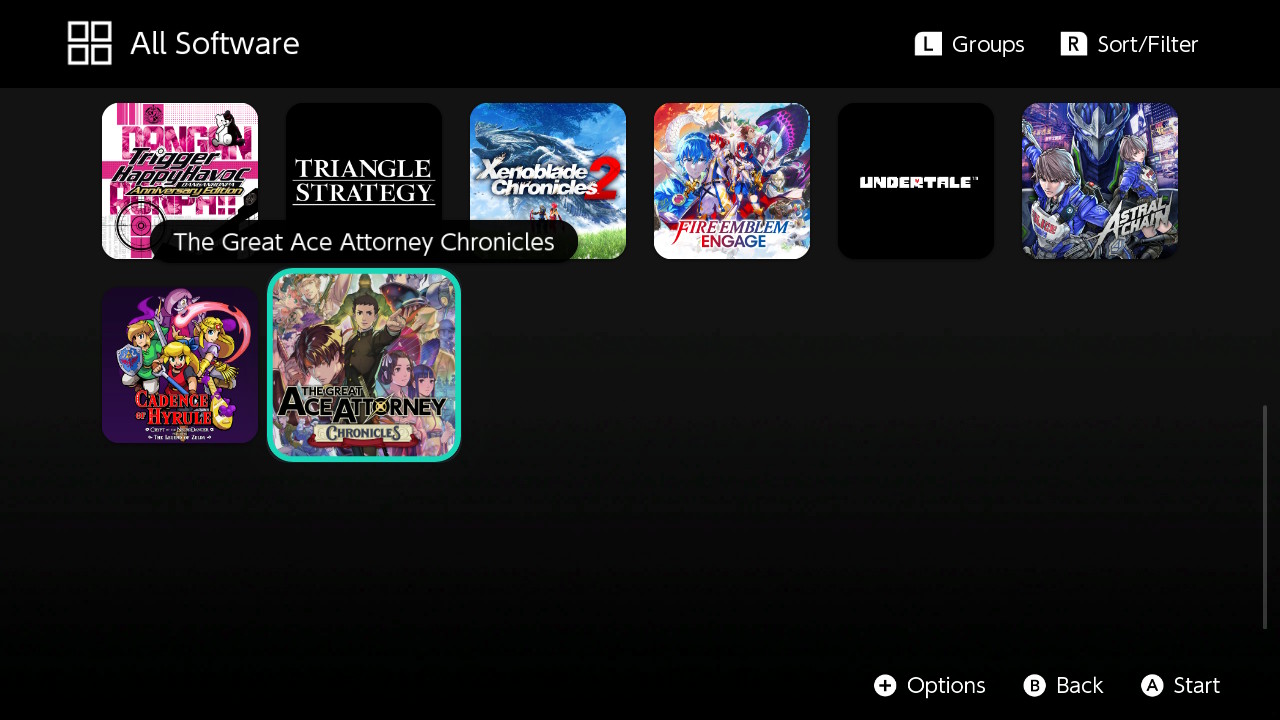 |
|---|---|
| Visible Redownload Software button | Hidden Redownload Software button |
Giving another example, take a look at my Unison R home menu theme: highlighted games have a white rounded card around their icon. These cards' corresponding pane is P_BtnBase from RdtBtnIconGame.bflyt. This pane actually has some transparency defined through animations by default. So in order to make this pane fully opaque, we need to look into the animations of P_BtnBase and change its KeyFrames value to 255 under the FLVC entry.